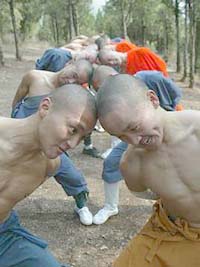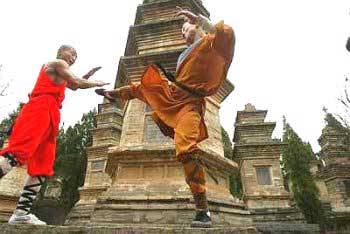The myriad sights of Songshan
by Celeste Fong, The Star, Nov 19, 2004
One of the cradles of human civilisation, the Songshan mountainous region boasts breathtaking scenery, philosophy, faith and Shaolin wushu martial artists, writes CELESTE FONG.
Mount Songshan is famous as the king of the five sacred mountains in China, taxi driver Zhang Wuxu says, describing to his passengers the Songshan mountains, the central one of the five sacred mountains. The Songshan range has 36 peaks with the highest peak measuring 1,494m above sea level.
 |
|
Songshan Shaolin wushu centre trainees practising ?hard qi gong? with their heads in the woods at Songshan mountain. |
The other four sacred mountains are Taishan in the East (Shandong), Huashan in the West (Shaanxi), Hengshan in the South (Hunan) and Hengshan in the North (Shanxi). (The two Hengshans are different in writing.)
We imagine how beautiful and magnificent the view of the Songshan mountains is surrounding Dengfeng city. The world-famous Shaolin Temple which was built during the Northern Wei Dynasty (386-534 BC) is just 15km north-west of Dengfeng.
From Zhengzhou Airport to Dengfeng city, he says the roughly-100km journey takes about one and a half hours after the completion of the new expressway in Henan Province last year.
Two years ago, two of our colleagues visited Mt Songshan during winter too but it took them more than three hours between Dengfeng city and Zhengzhou.
?Our vehicle almost knocked a cow down and this accident did delay us quite a bit,? one of them said before our trip to Mt Songshan.
Eager to learn more about the people and the place, I am all ears to Zhang, the driver.
Like many other well-informed cabbies, our taxi driver willingly shares with us local stories as well as the latest information during our journey here.
?See the trees along the roads. They are date trees. When I drive further away from the airport, you will see the farmers selling dates by the roadside,? he says in Mandarin.
He then asks if we have heard a local jingle that goes: ?Xinzheng dates are sweet and fragrant, and the home of dates is Mengzhuang.?
Mengzhuang town is located 25km northwest of Xinzheng and just south of Zhengzhou, the capital of Henan Province which covers 167,000sqkm with rugged mountains in the west and rich agricultural land in the eastern and central areas.
In autumn, he says, dates hanging on the tree branches look like red jewels and it is the best time to visit for the dates are ripe. Although we have just missed the best season, we can still taste dates any time here.
According to Zhang, the farmers who sit on their little wooden stools at the roadside sell their dates in the cold winter air until the daylight fades.
Passing the access road to the Daping mine, he says: ?So many reporters came here last month to cover the massive coal mine blast that killed hundreds of people. Such accidents are regular but last month?s was the deadliest.?
Henan is rich in natural resources. Its reserves of molybdenum, marble, asbestos, aluminium, natural gas, bauxite, coal and refractory clay are among the largest in China. In 1999, the province?s coal output reached 80mil tonnes and ranked third in China after Shanxi and Shandong.
The Zhongyuan oilfield, located between Henan and Shandong provinces, is one of the largest oilfields in the country. Henan which means ?the south of the river? in Chinese lies south of the Yellow River and is also called ?Zhongyuan? ? the heart of Ancient China and also the cradle of Chinese civilisation.
Today, Henan is China?s most populous province. It is populated by Han, Hui, Manchu, Mongolian and other ethnic groups with over 92 million people.
 |
|
Songshan Shaolin wushu centre trainees at the pagoda forest of the Shaolin temple in Henan province. The pagoda forest is a concentration of tomb pagodas for eminent monks, abbots and ranking monks at the temple. |
Henan?s attractions are numerous ? including the Shaolin Temple where both Chan Buddhism (or Zen Buddhism) and kung fu (martial arts) were born; the Longmen Grottoes; the ancient capital Kaifeng and China?s first capital Luoyang.
?Those who are in the coal mine business are filthy rich. And the children of petrol station owners here have often been made the prime targets of kidnappers,? so he says.
It is not a clear winter day when we step out of Zhengzhou Airport in the late morning, neither is it clear as we approach Dengfeng city, passing Xinmi city into the Xinmi coal mining district. The mist is not going away.
In the coal mining district, we see a road sign has been put up to warn road users that a stretch of road is in danger of sinking because the coals beneath the surface have already been mined leaving hollowed out space.
Zhang says that because of the potential danger, ?the residents in the old town of Xinmi have mostly moved to the new town of Xinmi in stages.?
After Xinmi, we are approaching Dengfeng city but we still cannot see the Songshan mountains which are renowned for standing craggy and high with the summit penetrating the sky.
Our relatively cold and foggy afternoon slips away in thicker mist enveloping Dengfeng city.
In the following days of our visit, our host, Master Feng Genhuai of Shaolin Wushu Centre, repeatedly points out the faint outline of the rugged Songshan mountains hidden in the mist-filled distance when driving us around in Dengfeng.
Only a few days later, indeed the very last day of our visit, when the winter fog clears away, the city then unveils more of its beauty with Songshan mountains as its backdrop ? Mt Songshan?s two high mountain ranges, Taishi and Shaoshi; and its many secluded shady valleys and marvellous steep peaks with distinctive deep lines on its rough rocks are simply breathtaking.
Having risen above the water surface about 500 million years ago and being one of the earliest scenes of human activities, Songshan is geologically very ancient land.
Its Songshan World Geological Park, regarded by geologists as a natural geology museum, has made its mark in Earth history and is an ideal place to study geo-evolution.
Here, Confucianism, Buddhism and Taoism co-existed and flourished in the same mountains where scholars of different religions and sages of different religious orders expounded their theories in the same neighbourhood and debated with one another to reach the same goal ? absolute goodness and ultimate harmony.
Therefore, it is not surprising that the area had one of the four most famous Confucian schools of higher education in ancient China, Songyang Academy, and the Taoist Zhongyue Temple, first built in Qin Dynasty (221-206 BC), that stood side by side with those of other faiths here for hundreds of years without causing any unfriendly feelings.
Dengfeng, being the birthplace of both Chan Buddhism and the famed Shaolin wushu, has a long history and a number of other sites worth visiting. The foremost on the list is the Shaolin Temple.
Besides the legendary Shaolin Wushu Centre of the Shaolin Temple, other Shaolin wushu schools mushroomed everywhere in Dengfeng. The number once grew to over 100, showing an incredible growth of Shaolin wushu.
The sight of wushu students in training and practising their kung fu moves ? one of the most evocative views in Dengfeng ? and the increasing number of Chinese and international visitors to the area are testimony of their appeal.
Now, Dengfeng has a total of 83 wushu schools comprising over 40,000 students. And the Songshan scenic area remains one of China?s top tourist attractions.


